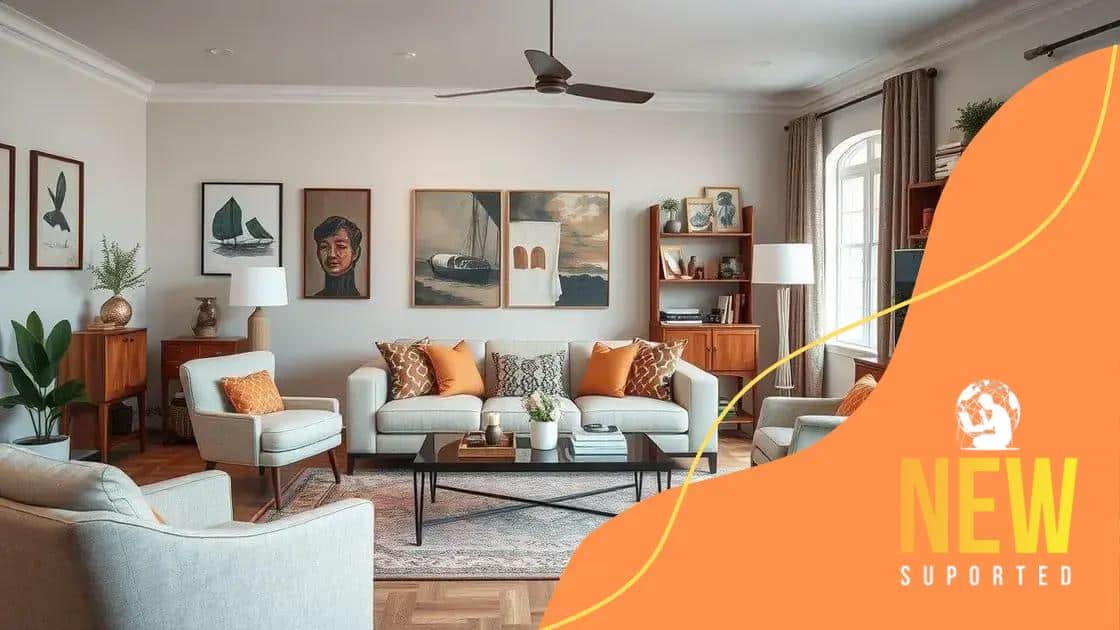How to blend different decor styles to create harmony

To blend different decor styles successfully, choose a primary style, limit combinations to two or three styles, maintain a consistent color palette, and ensure balance through scale and proportion.
Ever wondered how to blend different decor styles to create harmony in your home? It’s an art that can transform your space into a unique and inviting atmosphere. Let’s dive into some creative tips and tricks!
Understanding different decor styles
Understanding different decor styles is essential for creating an inviting space. Each style brings its own unique charm and character to your home, making it feel more personalized.
Popular Decor Styles
There are countless decor styles, but some are more popular than others. Here are a few notable ones:
- Modern: Clean lines and minimalism define this style, focusing on functionality.
- Bohemian: This eclectic style mixes colors, patterns, and textures, creating a laid-back vibe.
- Rustic: Natural materials and weathered looks aim to bring the outdoors inside.
- Industrial: Raw materials and exposed structures capture an urban, edgy aesthetic.
Each of these styles has its unique features and charm, which can be combined in various ways.
Mixing Styles
When blending styles, it’s crucial to maintain a cohesive look. You can accomplish this by choosing a common color palette or complementary textures. For example, if you love the modern style, consider adding a few bohemian elements, like patterned cushions or a vibrant rug. This creates a focal point that harmonizes the two styles.
Another tip is to use different pieces that relate in some way. For instance, a rustic wooden table can pair beautifully with modern metal chairs. This approach will give your home an interesting yet harmonious feel.
Ultimately, understanding different decor styles allows you to express your creativity and personal taste while making your space functional and beautiful. Remember, don’t be afraid to experiment and find what feels right for you!
Choosing a primary style for your space
Choosing a primary style for your space is a crucial step in achieving a harmonious look. It sets the tone for the entire room and influences your choices in furniture, colors, and decor.
Factors to Consider
When selecting your main decor style, think about your lifestyle and personal preferences. Consider how you use the space and what makes you feel comfortable. Here are some factors to keep in mind:
- Functionality: How do you intend to use the space? Make sure the style supports your needs.
- Existing Elements: Take note of any architectural features or furniture you already have that may influence your style.
- Color Preferences: Think about the colors that you love and how they fit with different styles.
- Space Size: The size of the room can impact which styles will work best.
Once you’ve considered these factors, you can narrow down your options to find a primary style that resonates with you. For instance, if you prefer a minimalist approach, focus on modern styles that emphasize clean lines and simplicity. Alternatively, if you enjoy a cozy aesthetic, you might lean toward rustic designs full of warmth and texture.
Creating a Cohesive Look
After selecting a primary style, you can begin to incorporate complementary elements from other styles while maintaining your chosen aesthetic. This approach allows for creativity without overwhelming the space. For example, combining a contemporary base with vintage accents can add character and uniqueness.
Visualizing how your primary style interacts with different decor elements can be helpful. Use mood boards or digital design tools to experiment with colors and arrangements before making any purchases. This way, you ensure everything works harmoniously together.
Mixing and matching elements effectively

Mixing and matching elements effectively allows you to create a unique look in your space. With the right balance, different styles can complement each other beautifully.
Finding Balance
To achieve harmony in your decor, it’s important to find a balance between various elements. Start by selecting a few core pieces that reflect your primary style. Then, add accents from different styles that you enjoy. This can include artwork, rugs, or small decor items.
- Contrast Colors: Pair bold colors with neutral tones to create a striking effect.
- Vary Textures: Combine smooth surfaces with rough textures to add depth.
- Mix Patterns: Don’t shy away from mixing different patterns. Just ensure they share a color palette.
- Layer Items: Layering adds interest. Use varying heights and shapes to create visual intrigue.
When you mix materials and styles, it’s essential to maintain some continuity. This can be done by having a consistent color theme throughout the elements chosen. For example, if you are blending modern and rustic styles, use natural wood tones in both styles to tie them together.
Creativity and Experimentation
Allow your creativity to shine while mixing decor elements. Visit local thrift stores or craft fairs to find unique pieces that speak to you. You can always make adjustments as you go, whether it’s rearranging furniture or changing out decor items as new inspirations arise.
One method is to start with a statement piece, like a bold painting or an antique coffee table. Build the rest of the decor around this feature to ensure everything feels cohesive. Innovation often springs from daring combinations, so don’t hesitate to try something new. Just remember to step back occasionally and ensure the overall look remains harmonious and inviting.
Tips for achieving balance and harmony
Tips for achieving balance and harmony in your decor can help you create a cohesive and inviting space. These principles will guide you to blend different styles while maintaining a sense of unity.
Start with a Color Palette
Selecting a color palette is fundamental for achieving harmony. Choose 2-4 main colors that you love and will use throughout the room. Incorporating these colors in various ways, like on walls, furniture, and accessories, will create a unified look
- Neutral Base: Start with a neutral base color for walls or large furniture.
- Accent Colors: Use your chosen accent colors in smaller decor items like pillows or artwork.
- Consistent Shades: Ensure that the shades used are consistent to avoid clashing.
With a selected color palette, every element in your room can work together, allowing for a harmonious feel.
Consider Scale and Proportion
Scale and proportion play an important role in decor harmony. Large pieces of furniture need to be balanced with smaller items to avoid overwhelming the space. Similarly, artwork should be sized appropriately for the wall it’s on.
Choosing pieces that match the scale of your room makes it more inviting. Large rooms can handle more substantial furniture, while smaller spaces benefit from lighter, more streamlined options.
Mixing textures is another way to create interest without disrupting balance. Soft textiles can complement harsher materials like metal or wood.
Use Repeating Elements
Another effective technique for achieving harmony is to use repeating elements throughout your decor. This can be something as simple as a pattern or material, like a specific fabric or color.
- Consistent Patterns: Use the same pattern in different items, such as curtains and cushions.
- Materials: Consider repeating materials like wood and metal in various pieces.
- Shapes: Integrate similar shapes to create visual rhythm.
By repeating elements, you can tie together various styles and pieces, making the overall design feel more cohesive and intentional.
Common mistakes to avoid when blending styles
Common mistakes to avoid when blending styles can help ensure your decor remains cohesive and inviting. Being aware of these pitfalls can save you time and effort while making your space more harmonious.
Overly Complicated Combinations
One of the biggest mistakes is trying to mix too many styles at once. While it’s tempting to include every decor piece you love, doing so can create visual chaos. Instead, focus on two or three styles that complement each other well.
- Choose a Primary Style: Let one style be the focus and use others as accents.
- Avoid Clashing Patterns: Be mindful of different patterns that may compete for attention.
- Limit the Color Palette: Stick to a simple color scheme to maintain harmony.
Keeping combinations simple will make your decor feel intentional and pulled together.
Ignoring Scale and Proportion
Another common mistake is ignoring scale and proportion when selecting furniture and decor items. Mixing large, bulky pieces with tiny accents can create an unbalanced look. Be sure to select items that fit the scale of your room.
For example, a large sectional sofa should be complemented with larger decorative items, such as a sizeable coffee table or artwork, to maintain a sense of balance. On the other hand, opting for smaller furniture in a spacious room can make the space feel empty.
Neglecting Personal Style
Many people focus on trends instead of their own personal style. While it’s tempting to follow the latest decor fads, neglecting your preferences can lead to a space that feels impersonal.
Embrace pieces that resonate with you and reflect your personality. Your space should tell your story, so integrating unique items that hold significance will create a more meaningful environment.
Lastly, be cautious about the cohesion of the elements. Ensure that everything you choose can connect with your overall aesthetic, as this will keep your space feeling warm and inviting.
FAQ – Common Questions About Blending Decor Styles
What are some tips for blending decor styles?
Focus on choosing a primary style, maintain a consistent color palette, and incorporate personal elements to create a cohesive look.
How many styles can I mix in one space?
It’s best to limit yourself to two or three styles to avoid a cluttered and chaotic appearance in your decor.
How can I ensure balance when mixing different decor elements?
Pay attention to scale and proportion, use repeating elements, and mix textures to achieve balance and harmony in your decor.
What common mistakes should I avoid when blending styles?
Avoid overcomplicating combinations, neglecting personal style, and ignoring scale and proportion to maintain a harmonious space.






